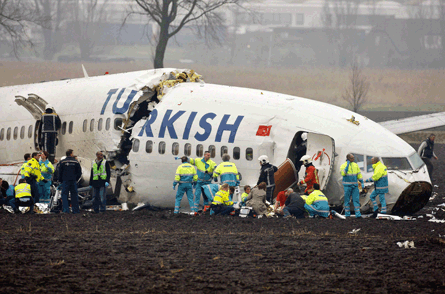Dutch accident investigators have determined that the radio-altimeter fault that is the focus of their probe into the fatal loss of a THY Turkish Airlines Boeing 737-800 at Amsterdam Schiphol had occurred on several of the nine previous flights by the aircraft.
On two of the flights, which were retained on the digital flight data recorder (DFDR), the fault caused the autothrottle to enter retard mode and the throttles to close as they did on the accident flight.
The investigators note that Boeing guidance is that the autopilot and autothrottle should not be used on approach, as they were on the accident flight, if the radio altimeter malfunctioned on the previous flight. It is not stated whether a malfunction was in fact identified on the previous flight.
In their preliminary report they also describe how the aircraft entered the glidepath from above rather than below, and only decelerated to the correct approach speed of 144kt at an altitude of 770ft. With the throttles at idle, the aircraft's speed subsequently fell to 110kt at 420ft and a last-ditch attempt by the crew to recover was unsuccessful.
 |
|---|
© Sipa Press/Rex Features |
The report relates how, in daytime and good weather on 25 February, the aircraft (TC-JGE), which was otherwise found to be fault-free, was flown from Istanbul to Amsterdam by the crew consisting of a line-training captain, a first officer performing a "line flight under supervision (LFUS)", and another first officer in the jump seat required as a safety pilot during a LFUS. All three died, as well as a flight attendant and five passengers.
The left-hand radio altimeter, which feeds the autopilot and autothrottle, recorded its maximum permissible altitude of 8,191ft until the aircraft descended to an actual altitude of about 1,950ft when the recorded value "suddenly changed to -8ft and remained at that value up until shortly before impact".
Cockpit voice recorder data shows that "several aural landing configuration warnings" - for flaps and landing-gear - sounded at altitude and then again while on the approach, when they were triggered by the low radio-altitude reading. The warnings and the crew's reaction are still being examined.
The investigators say the standard procedure for runway 18R at Amsterdam is for air traffic control to line up aircraft at 8nm and 2,000ft altitude, but a line-up of 5-8nm may be offered. The Turkish flight lined up at 6nm and 2,000ft and descended to onto the glidepath from above, the crew selecting vertical-speed mode to attain the glidepath at 1,330ft. They reduced speed from their initial 165kt to the correct 144kt by 770ft, selecting 40° flap at 900ft.
At the same time the autothrottle "entered the retard mode" normally engaged during the landing flare and the thrust levers went to idle. The speed continued to decay and the autopilot steadily commanded nose-up to try to maintain the glideslope.
Eventually the stick-shaker, warning of an imminent stall, triggered at about 460ft. The report says the thrust levers were immediately advanced but "moved back to idle" and the autothrottle disengaged, either by the crew or automatically. Speed by then was 110kt, the aircraft 11° nose-up, and the angle of attack at about 20°.
At 420ft the crew disengaged the autopilot and attempted to recover, reaching 8° nose-down at 310ft with full-power then generating a slight climb, but it eventually reached a 22° nose-up attiude with 10° left bank before crashing 1.5km from the threshold. The fuselage broke in two places and the cockpit and cabin were severely damaged. Eighty-six occupants were injured, in addition to the nine fatalities.
The report states: "The door between the cabin and the cockpit was found partly opened."
It concludes: "The Dutch Safety Board has issued a warning to Boeing in which extra attention is asked for a part of one of the manuals (737 dispatch deviations guide) of the Boeing 737. In this guide it is stated that if, [during the] preceding flight, the radio altimeters are malfunctioning, the associated automatic pilots and autothrottle systems cannot be used for approach and landing. The board has given Boeing into consideration to investigate if these procedures should also be valid during all phases of a flight.
"Boeing has issued a multi-operator message the same day concerning malfunction of the radio altimeters."
- Kieran Daly thinks will change views about the crew's performance. Read his blog.
- Turkish Airlines profile page
- Boeing 737 profile page
- THY Schiphol accident images
Source: Air Transport Intelligence news
















